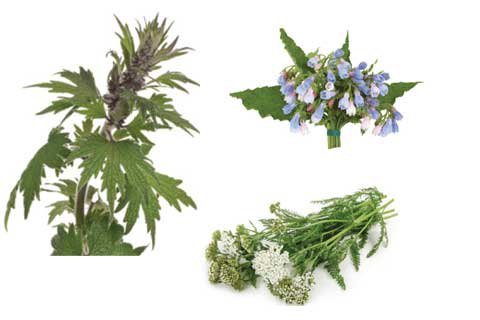
herbs
I work at Herb Haven, a horticultural therapy program for women and children located outside Canandaigua, NY. The women who come to Herb Haven range from mothers with young children to women just welcoming new grandchildren into their lives. They all have an interest in learning to use herbs for wellness and many of them are already herbalist in their own right. I decided to ask the women of Herb Haven which herbs and plants they most recommend for supporting natural health alternatives for themselves and their families. The list includes herbs you can grow yourself as well as wild-crafted “weeds.” If in doubt of your identification skills, you can always visit a local herbalist to purchase organically grown dried herbs, pre-made teas, tinctures, and salves.
Motherwort “I like motherwort for general women’s wellness,” says Deb Denome, Herb Haven Director and Educator. “Motherwort is a helpful ally for every phase of a woman’s life: from first menarche through childbearing years to the wise women years.” The alkaloids in the plant are useful for menstrual cramps and labor, as well as bringing on delayed menses. It’s also a wonderful tonic for nervousness, anxiety and heart palpitations. Deb recommends purchasing a tincture from a local herbalist as it’s not a pleasant tasting tea.
Yarrow Our teen herbcraft assistant, Petra, says her favorite useful herb is yarrow. “I’ve used it to fight infection and staunch bleeding on bad cuts,” she says. “Just pick off a few leaves and masticate them in your mouth and put them on the cut.” You can make a simple poultice as well. Petra loves the styptic quality of yarrow and has used it for herself, friends, and even farm animals in need. A tea from the flowers is reputed to be good for upper respiratory infections.
Calendula and Comfrey “I feel most drawn to comfrey. I have used it in a salve and also as a poultice on my knees after surgery,” says Liz. “But I don’t think I know all that it has for me yet.” Comfrey is also known in folk medicine as boneknit and has a long history as being useful for healing breaks and fractures both internally and externally. Comfrey is wonderful for hair rinses too! “But calendula salve is the most valuable herb I use with my family,” Liz adds. “Robert, my son, calls it our magic salve and we use it for sores, eczema, wind burn and chapped skin.”
Lavender Joy’s favorite herb is lavender, known for its floral scent and relaxing properties. Lavender essential oil can be used in a diffuser or added to homemade vinegar cleaning products to help create a peaceful home atmosphere. Lavender oil is also a remedy for insect stings and burns. The blossoms can be added to a weak tea to help alleviate migraines, tension, and depression. Lavender flowers can also be added to bath bags. Lavender should not be used in high concentrations if pregnant.
Home Cure-alls
VINEGAR: Because of its natural anti-fungal and anti-bacterial properties, vinegar has hundreds of uses for home and health. For athlete’s foot, ringworm, and other fungal infections, wash affected area with white vinegar 2-3 times a day. Apple cider vinegar is also great for swimmer’s ear and other ear infections: soak a cotton pad in vinegar and place gently in the ear. Hold in place for at least 20 minutes. Cider vinegar works well as a natural deodorant wiped under the arms after a shower (the vinegar smell dissipates fairly quickly). A tablespoon diluted in an 8 oz glass of water is a good cure for heartburn, indigestion, acid reflux and even ulcers.
ALOE: Aloe is a lovely houseplant whose inner gel has healing properties for treating burns, dry skin, eczema and even fungal infections (it’s not recommended for staph infections, however). It’s very gentle on sensitive skin. No home should be without at least one aloe plant!
HOT WATER BOTTLE: This old-timey invention is a stand-by for all sorts of ailments, from chest colds, to menstrual cramps, ear aches, sore muscles and even drawing impurities from the liver when applied with a castor oil pack over the liver.
EPSOM SALT FOOT BATHS: A warm Epsom salt foot bath relieves tension and headaches, eases back aches, and pulls impurities from the body. A cool Epsom salt foot bath soothes tired feet and invigorates the whole body. Essential oils and herbs can also be added. Foot baths are a great way to calm over excited kids or just to give mom a break – and Epsom salts are great for sore muscles as a shower scrub or in the bath.
SALVES: “We’ll have to put some salve on that,” I tell my little girl who looks at me and says, “Is salve your answer for everything?” I have to laugh because actually, it probably is. Salves are relatively easy to make and can be individualized with homegrown ingredients to serve your family’s needs. First you need to make an herbal infusion in olive or other quality oil. Beeswax is then melted into the final oil to thicken it into a salve.
Healthful Recipes & Homemade Cures
BASIC SALVE RECIPE• 1 cup herb-infused oil per ¼ cup of beeswax.• Completely cover chopped herbs with oil and steep on the stove for 35-45 minutes (or better yet, allow herbal oil mixture to steep in a sunny window for two weeks; a mason jar works well. Make sure herbs are entirely covered so they don’t mold.)• Pour and strain infused oil.• Measure desired amount in a double boiler and add shaved beeswax. It’s always good to test a small amount and allow it to cool to determine if enough beeswax has been added.Calendula salves are wonderful for baby bottoms, eczema, and rashes and can be mixed with chickweed, plantain, and comfrey. Comfrey salves are great for muscle and bone injury, burns, blisters and speeding healing. St. Johns Wort is antiseptic, antiinflammatory, and I’ve found the oil provides instant nerve pain relief. Use a single herb or mix your own combination; add essential oils like eucalyptus to make your own vapor rub. We make a Super Salve at Herb Haven that has a little of each of the great healing herbs.
HEADACHE TEA• 2 parts lemon balm• 1 part lavender flowers• 1 part feverfew flowers
IMMUNE BOOST TEAThese ingredients help strengthen the immune system, fightviruses, and supply added vitamins.• Echinacea• Goldenseal root• Elderberries• Boneset (be frugal – this stuff tastes very strong)• For sore throats, add sage. (You can drink sage tea by itself.)
KID’S TUMMY TEA• Peppermint• Lemon balm• Catnip or chamomile (for a stress tummy ache)• Fennel seed and marsh mallow root (for constipation)• Add honey to flavor
CALMNESS BLEND• Lemon balm• Wild or un-hulled oats• Chamomile• Rose petals or lavender“
OPEN ARMS” COLD CUREMy friend at Open Arms Yoga studio says she uses this cure for the entire family.• 2-3 cloves garlic• Several slices of ginger root• Several dashes of cayenne pepper• 1 tsp lemon juice• 1 T honey• 2 cups water1. Simmer garlic and ginger in a small pot of water for 15-20 minutes.2. Add cayenne, lemon and honey.3. Drink hot and eat the garlic when done!
CHILDREN’S COLD SYMPTOM ELDERBERRY SYRUP• 1 cup whole or 1/2 cups dried elderberries (the blue ones not the red!)• 2 cup honey or other sweetener• 1 tsp lemon juice• 3 cups water1. Simmer the Vitamin C rich elderberries in a covered pot for 20-30 minutes, crush and strain.2. Add sweetener and lemon juice.3. Strain and serve.You can also store this in a sealed jar in the refrigerator for several weeks. Other herbal syrups you can make include Echinaceaginger root (for colds), blackberry leaf syrup (for mild diarrhea) and lemon balm (for stressed or anxious children).
ACID REFLUX AND NAUSEA CURE• 2 cups apple cider vinegar• ¼ cup bee balm leaves and flowers1. Steep bee balm in cider vinegar, just boiled, for twenty minutes.2. Strain and bottle.Take a teaspoonful a couple times a day (you may dilute it in a glass of water if you wish). You can also make this remedy ahead of time by infusing bee balm in the vinegar in a dark jar for two or three weeks, shaking occasionally.
Other Natural Remedies for Ailments
FOR CHEST CONGESTION: Rub Tiger Balm, Bag Balm or Vapor Rub on chest and back. Place a hot water bottle on the back, alternating front and back. Be careful not to get balms and oils in eyes or mucus membranes.
WARTS: Dab the milky white juice of dandelions on the wart a couple times a day until it disappears.
SORE THROAT: Gargle with a fresh brewed sage tea several times a day. Or gargle with a mix of 1T baking soda in water, or brew a garlic clove in a cup of water and then add baking soda.
COUGHS: Mix 1 tsp apple cider vinegar with 1 tsp honey. Elecampane (Inula helenium) is a wonderful herb for coughs. The root is harvested in the fall and can be tinctured, made into syrups, or candied for winter coughs. Or, cook a chopped, red onion with honey or sweetener until it becomes a syrup. Strain and give by the spoonful.
Angela Cannon-Crothers is a contributing writer to Rochester Area & Genesee Valley Parent Magazine. She is an an educator at Herb Haven in Crystal Beach as well as a writer and author. She lives in Upstate, NY. You can visit her website atangelacannoncrothers.webs.com
Views: 1






